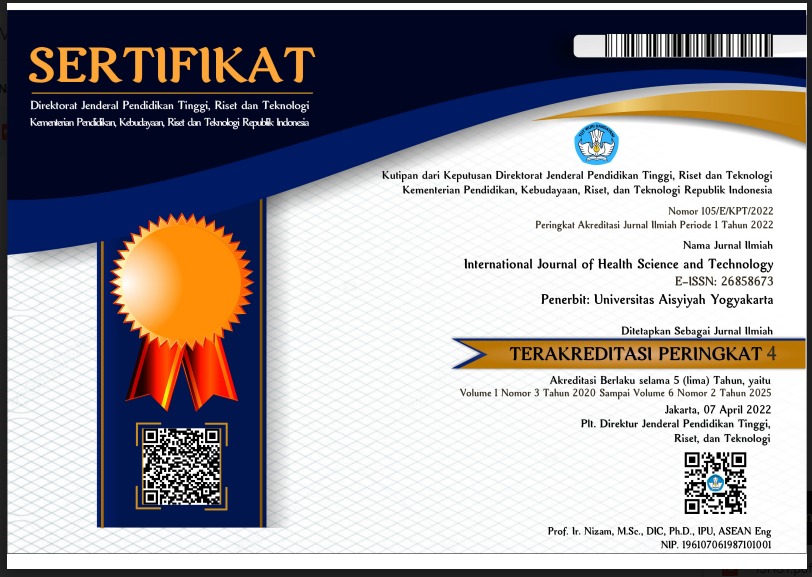Improving the Students’ Self-confidence in Speaking English through YouTube
DOI:
https://doi.org/10.31101/ijhst.v2i3.2173Keywords:
self-confidence, speaking skill, YouTube, English Language TeachingAbstract
Downloads
References
Aamer Qureshi I. The Importance of Speaking Skill For EFL Learners. Gerald Gillis. 2013;
Srinivas Rao P. the Importance of Speaking Skills in English Classrooms. Alford Counc Int English Lit Journal(ACIELJ). 2019;
James PRAP, Yong KL, Yunus MM. Hear Me Out! Digital Storytelling to Enhance Speaking Skills. Int J Acad Res Bus Soc Sci. 2019;
Leong L-M, Ahmadi SM. An Analysis of Factors Influencing Learners’ English Speaking Skill. Int J Res English Educ. 2017;
Paramitha GT. TINGKAT PERCAYA DIRI PESERTA DIDIK. Kesehatan. 2016;
Khalil AH, El-nagar BEE, Awad MAE. The Effect of Brain-Based Learning on Developing Some Speaking Skills of Egyptian EFL Secondary School Students. 2019;14(3):103–16.
Heriansyah H. SPEAKING PROBLEMS FACED BY THE ENGLISH DEPARTMENT STUDENTS OF SYIAH KUALA UNIVERSITY. Ling Didakt J Bhs dan Pembelajaran Bhs. 2012;
Tuan NH, Mai TN. Factors Affecting Students’ Speaking Performance at Le Thanh Hien High School. Asian J Educ Res. 2015;
Daeli R, Kurnianingtias EA. Measuring Self-Confidence of Teenage Students of Sekolah Cita Buana.
Bunaya MS, Basikin. Improving Speaking Confidence by Using Think Pair Share (TPS) Teaching Strategy to High School Students. In 2019.
Oktavia (2016) NA. ENHANCING STUDENTS’ SELF CONFIDENCE TO OVERCOME SPEAKING PROBLEM By Nidya Andini Oktavia. :1–10.
Kurniawati A. Using Role-Play Technique for the Eight Grade. 2013;i–152.
Mareta silviani (University of L. Improving the Self-Confidence in Speaking Practice by Using Self-Directed Dialogue Technique at Second Grade Students’ of SMP Negeri 1 Kalirejo Lampung Tengah. 2019;300.
Mulyani H. PENGGUNAAN MEDIA SOSIAL SEBAGAI PENUNJANG DALAM PEKULIAHAN ANGGARAN PERUSAHAAN DI PROGRAM STUDI PENDIDIKAN AKUNTANSI. J Pendidik Akunt Keuang. 2019;
Su YR, Fatmawati F. Fostering Students’ Self-Esteem in Speaking by Extending Speaking Activities in Social Media. Pedagog J English Lang Teach. 2019;7(1):65.
Moghavvemi S, Sulaiman A, Jaafar NI, Kasem N. Social media as a complementary learning tool for teaching and learning: The case of youtube. Int J Manag Educ. 2018;
Lee DY, Lehto MR. User acceptance of YouTube for procedural learning: An extension of the Technology Acceptance Model. Comput Educ. 2013;
Jaffar AA. YouTube: An emerging tool in anatomy education. Anat Sci Educ. 2012;
Quasi-Experimental and Single-Case Experimental Design. 2019;5–16.
Downloads
Additional Files
Published
How to Cite
Issue
Section
Citation Check
License
International Journal of Health Science and Technology allows readers to read, download, copy, distribute, print, search, or link to its articles' full texts and allows readers to use them for any other lawful purpose. The journal allows the author(s) to hold the copyright without restrictions. Finally, the journal allows the author(s) to retain publishing rights without restrictions
- Authors are allowed to archive their submitted article in an open access repository
- Authors are allowed to archive the final published article in an open access repository with an acknowledgment of its initial publication in this journal

This work is licensed under a Creative Commons Attribution-ShareAlike 4.0 Generic License.













